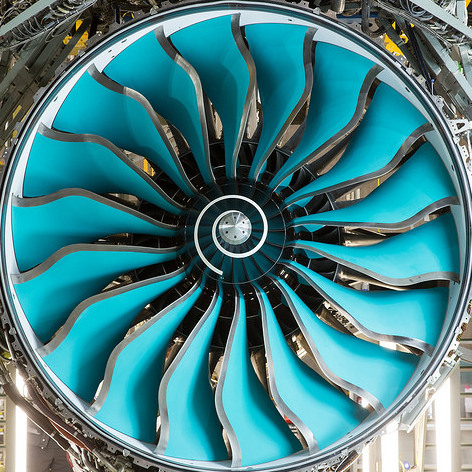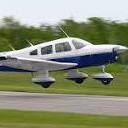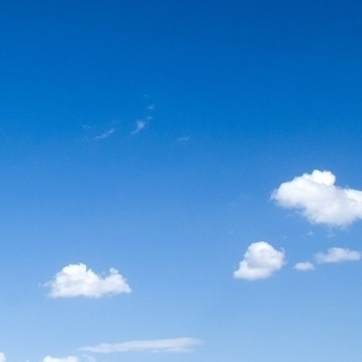Moderators: richierich, ua900, PanAm_DC10, hOMSaR
-

- RRUltrafan
- Posts: 43
- Joined:
Turbofan engine Growth
What determines the capability of the amount an engine can grow and be developed without changing the design? E.g the PW4000 on the 777 was maxed out in terms of growth, and I'm curious what design aspect determines this, and why?
-

- Revelation
- Posts: 29623
- Joined:
Re: Turbofan engine Growth
Not an expert ( paging Lightsaber ) but from what I've read about the last few generations of changes to engines, a lot of things.
Jets work by increasing air pressure and temperature. Things like core blades and engine casings have limits with regard to temperature and pressure, so if you want more pressure and/or higher temperature, you need a new engine.
A lot of advancement comes from advancements in cooling the engine, and quite often to take advantage of improvements in that area you need a new engine because the old one can't support newer cooling techniques.
Other big architectural changes like contra-rotation (inner spool spins opposite direction of outer spool(s)) requires enough changes to require a new engine.
Another case is better aerodynamics of the core's blades creates more energy so you can now get more non-core air (i.e. bypass flow) so either you need a bigger fan or can get away with a smaller core so you need a new engine that can take case of the new configuration.
Adding a gear like PW1100G lets you spin the fan at an optimal rate so you need less energy for it, and so you can remove stages from the compressor and turbine, so the engine itself becomes shorter and you need room for the gear, so that's an all new engine.
Jets work by increasing air pressure and temperature. Things like core blades and engine casings have limits with regard to temperature and pressure, so if you want more pressure and/or higher temperature, you need a new engine.
A lot of advancement comes from advancements in cooling the engine, and quite often to take advantage of improvements in that area you need a new engine because the old one can't support newer cooling techniques.
Other big architectural changes like contra-rotation (inner spool spins opposite direction of outer spool(s)) requires enough changes to require a new engine.
Another case is better aerodynamics of the core's blades creates more energy so you can now get more non-core air (i.e. bypass flow) so either you need a bigger fan or can get away with a smaller core so you need a new engine that can take case of the new configuration.
Adding a gear like PW1100G lets you spin the fan at an optimal rate so you need less energy for it, and so you can remove stages from the compressor and turbine, so the engine itself becomes shorter and you need room for the gear, so that's an all new engine.
Re: Turbofan engine Growth
Definitely a Lightsaber question.
*pulls up a chair, ready to listen*
*pulls up a chair, ready to listen*
Re: Turbofan engine Growth
Shrink the core - enlarge the fan diameter.
Re: Turbofan engine Growth
The core has to spin the fan. Putting another low pressure turbine often allows more shaft horsepower to be extracted from the core.
A geared turbofans has a big advantage as you could change GE the gear ratio to fit a larger slower fan. So with the same shaft horsepower you can produce more total thrust.
You can actually make the core bigger by sticking an extra low pressure stage on the front. Each stage then has a little bit extra pressure causing the total core pressure and temperature to increase. You often see this with a mature core as a way to get more maximum take. The Trent series often does this on the IP stages and is a good way to scale up a hot section.
When an engine is made smaller they can often do the opposite remove the first low pressure compressor stage to reduce the core size. You can see this on the E-175 and MRJ geared turbofans.
Usually most growth comes from cooling of the back end. Being able to run the engine hotter and faster allows more power to be extracted to run the fan. It might takes years of service and testing to eliminate the weak spots to allow an engine core to be "turned up"
A geared turbofans has a big advantage as you could change GE the gear ratio to fit a larger slower fan. So with the same shaft horsepower you can produce more total thrust.
You can actually make the core bigger by sticking an extra low pressure stage on the front. Each stage then has a little bit extra pressure causing the total core pressure and temperature to increase. You often see this with a mature core as a way to get more maximum take. The Trent series often does this on the IP stages and is a good way to scale up a hot section.
When an engine is made smaller they can often do the opposite remove the first low pressure compressor stage to reduce the core size. You can see this on the E-175 and MRJ geared turbofans.
Usually most growth comes from cooling of the back end. Being able to run the engine hotter and faster allows more power to be extracted to run the fan. It might takes years of service and testing to eliminate the weak spots to allow an engine core to be "turned up"
-

- ElroyJetson
- Posts: 1751
- Joined:
Re: Turbofan engine Growth
All engines theoretically run more efficiently the greater the core temperature. That goes for steam engines, to internal combustion, to jet turbines.
The "work" of the engine is the temperature variance between the hot core and cool outer chamber. It is the fundamental idea of thermodynamics. Hence the reason why a high bypass turbofan is so much more efficient than first generation turbo jets.
Material experts have talked for years about using ceramics as engine cores because they tolerate very high temperatures so well. The problem is they are brittle and difficult to machine.
It anyone could develop a material that can tolerate extremely high temperatures like ceramics with the durability and machinability of metal would probably win a Nobel Prize.
Get cracking people.
The "work" of the engine is the temperature variance between the hot core and cool outer chamber. It is the fundamental idea of thermodynamics. Hence the reason why a high bypass turbofan is so much more efficient than first generation turbo jets.
Material experts have talked for years about using ceramics as engine cores because they tolerate very high temperatures so well. The problem is they are brittle and difficult to machine.
It anyone could develop a material that can tolerate extremely high temperatures like ceramics with the durability and machinability of metal would probably win a Nobel Prize.
Get cracking people.
-

- kitplane01
- Posts: 2917
- Joined:
Re: Turbofan engine Growth
RJMAZ wrote:
When an engine is made smaller they can often do the opposite remove the first low pressure compressor stage to reduce the core size. You can see this on the E-175 and MRJ geared turbofans.
Why would your prefer to remove the *first* low pressure compressor stage? I would think that by removing that one you change the conditions for all the other compressor stages away from the design optimum. I would have thought you would remove the *last* stage, since that would not change conditions for the stages in front.
Re: Turbofan engine Growth
[sits down, waits for Lightsaber's reply. Has a thought based on engine trends but it's really more a question to Lightsaber - am I thinking in the right direction?]
Given:
...given these trends I notice, it appears that the highest growth models within an engine family pay an SFC price for their higher T/W. OPR doesn't add fuel efficiency past some point unless max temp rises with it, it just gets more work from the engine (while spinning the fan faster - lower propulsive efficiency).
If I'm right about that, then there's some crossover point where the benefits of uprating:
(1) lower engine weight for given thrust
(2) lower engine nacelle drag for given thrust
(3) lower engine acquisition cost for cheaper-to-develop derivative versus lower-SFC but more expensive optimized engine
(4) shorter MLG and/or ability to fit underwing
...where these benefits of up-rating are outweighed by:
(1) lower SFC
(2) higher maintenance cost and on-wing time for highly-stressed up-rated model.
The range of up-rating within a family seems to settle around ~33% difference between most- and least-powerful family members (CFM LEAP, for example, spans 24k thrust to 32k).
That might be totally wrong - engines are mostly a black box to me at this point. Hopefully Lightsaber will correct where necessary or just tell everyone to skip this reply.
Given:
- (1)that max core efficiency is dictated by max temperature
- (2) given that an engine family can have a broad range of thrust levels that broadly correlates with increases to OPR
- (3)given that the highest-rated members of engine families, all else being equal, tend to have slightly lower SFC (TXWB-97 is an exception, but not all else is equal there)
...given these trends I notice, it appears that the highest growth models within an engine family pay an SFC price for their higher T/W. OPR doesn't add fuel efficiency past some point unless max temp rises with it, it just gets more work from the engine (while spinning the fan faster - lower propulsive efficiency).
If I'm right about that, then there's some crossover point where the benefits of uprating:
(1) lower engine weight for given thrust
(2) lower engine nacelle drag for given thrust
(3) lower engine acquisition cost for cheaper-to-develop derivative versus lower-SFC but more expensive optimized engine
(4) shorter MLG and/or ability to fit underwing
...where these benefits of up-rating are outweighed by:
(1) lower SFC
(2) higher maintenance cost and on-wing time for highly-stressed up-rated model.
The range of up-rating within a family seems to settle around ~33% difference between most- and least-powerful family members (CFM LEAP, for example, spans 24k thrust to 32k).
That might be totally wrong - engines are mostly a black box to me at this point. Hopefully Lightsaber will correct where necessary or just tell everyone to skip this reply.
Re: Turbofan engine Growth
RRUltrafan wrote:What determines the capability of the amount an engine can grow and be developed without changing the design?
I guess it depends in part on what you mean by "without changing the design".
I don't pretend to be an engine expert, but thinking about it, I can imagine:
- local changes that don't affect the rest of the engine (much!): blade shape refinements, coating refinements, FADEC twiddles, combustor tweaks, etc. I'd be surprised if there were more than a couple percentage points in all of this together, assuming that the original engine wasn't significantly under-tuned.
- More global changes that don't affect casing shape or significant weight / balance / force handling changes: GEnx's PIP1 (more LPT blades) might fall into this category, as might new a new combustor design (as long as it still fits in the original space). This sort of thing is obviously a spectrum but with this level of change you might be finding 4-5%, maybe a bit more?
After that, it would seem to get hard. Going from blade/rotor to blisk might be retrofittable (design-wise) but I'd guess it would change the thrust and weight picture enough to get into major shaft and bearing changes. Contra-rotation, changing number of stages, gearing, variable blade angles, materials change (eg CMC), etc, all have engine-wide effects that surely constitute a major evolution if not an entirely "new" design.
Re: Turbofan engine Growth
In a closed cycle like a steam turbine the limiting factors for efficiency is the difference between the top temperature and the bottom temperature as that defines the max work that can be done.
Unfortunately it is too many years and too many beers since I was last involved in engineering for me to remember the open cycle equations.
Unfortunately it is too many years and too many beers since I was last involved in engineering for me to remember the open cycle equations.
Re: Turbofan engine Growth
I would imagine that there is post launch modelling refinement such that the margins for error within the models reduce and the boundaries can be pushed. The design might not change but the confidence in the design does.
Fred
Sent from my iPhone using Tapatalk
Fred
Sent from my iPhone using Tapatalk
Re: Turbofan engine Growth
Assuming that the question of "growth" is asking about how to increase thrust specifically, then:
Prior responses are good from a technical point of view. Core output is limited by material capability at temperature and mass flow. You can keep raising the temperature without growing the core , but without a material substitution you will reduce durability and likely (depending on what limits that particular design), you may limit time on wing. You can raise mass flow with newer and better aerodynamics, thus increasing flow at the same diameter, at the cost of changing one or many stages of airfoil. You can destage the compressor and raise flow, but that's a bigger change. On the LP side you have similar options for LPT material selection and fan airflow, if you are constraining fan diameter.
However: there is another set of constraints, those being how these changes get implemented, and their cost. For example if you change the speed-speed relationship by changing fan aero, you now have a different engine behavior and you have a large expensive certification program for aircraft response, and new aircraft software as well as engine software. If you change fan or core aero you very likely will have to repeat icing, surge/stall, hail, rain, etc. If you change fan diameter you will have a new case design, and very likely have to repeat fan blade out. If you change the combustor aero you will have to repeat in flight starting. And on and on, so the cost of implementation can be prohibitive, depending on the market for the new variant. Then there is the supply chain impact. If the original engine is still in production you will have to decide whether all thrust variants now are produced to the new bill of materials; or whether to permit a split production system and ask the supply chain to manage both. Then there is the customer impact: spares are no longer compatible with all engines; or the new materials raise the cost of maintenance; or lower time on wing; etc.
So when you read that a certain model is out of gas, it may be that a certain set of changes is technically possible: but does not make sense from another point of view.
Prior responses are good from a technical point of view. Core output is limited by material capability at temperature and mass flow. You can keep raising the temperature without growing the core , but without a material substitution you will reduce durability and likely (depending on what limits that particular design), you may limit time on wing. You can raise mass flow with newer and better aerodynamics, thus increasing flow at the same diameter, at the cost of changing one or many stages of airfoil. You can destage the compressor and raise flow, but that's a bigger change. On the LP side you have similar options for LPT material selection and fan airflow, if you are constraining fan diameter.
However: there is another set of constraints, those being how these changes get implemented, and their cost. For example if you change the speed-speed relationship by changing fan aero, you now have a different engine behavior and you have a large expensive certification program for aircraft response, and new aircraft software as well as engine software. If you change fan or core aero you very likely will have to repeat icing, surge/stall, hail, rain, etc. If you change fan diameter you will have a new case design, and very likely have to repeat fan blade out. If you change the combustor aero you will have to repeat in flight starting. And on and on, so the cost of implementation can be prohibitive, depending on the market for the new variant. Then there is the supply chain impact. If the original engine is still in production you will have to decide whether all thrust variants now are produced to the new bill of materials; or whether to permit a split production system and ask the supply chain to manage both. Then there is the customer impact: spares are no longer compatible with all engines; or the new materials raise the cost of maintenance; or lower time on wing; etc.
So when you read that a certain model is out of gas, it may be that a certain set of changes is technically possible: but does not make sense from another point of view.
-

-
lightsaber
Moderator
- Posts: 24641
- Joined:
Re: Turbofan engine Growth
Matt6461 wrote:[sits down, waits for Lightsaber's reply. Has a thought based on engine trends but it's really more a question to Lightsaber - am I thinking in the right direction?]
Given:
- (1)that max core efficiency is dictated by max temperature
- (2) given that an engine family can have a broad range of thrust levels that broadly correlates with increases to OPR
- (3)given that the highest-rated members of engine families, all else being equal, tend to have slightly lower SFC (TXWB-97 is an exception, but not all else is equal there)
...given these trends I notice, it appears that the highest growth models within an engine family pay an SFC price for their higher T/W. OPR doesn't add fuel efficiency past some point unless max temp rises with it, it just gets more work from the engine (while spinning the fan faster - lower propulsive efficiency).
If I'm right about that, then there's some crossover point where the benefits of uprating:
(1) lower engine weight for given thrust
(2) lower engine nacelle drag for given thrust
(3) lower engine acquisition cost for cheaper-to-develop derivative versus lower-SFC but more expensive optimized engine
(4) shorter MLG and/or ability to fit underwing
...where these benefits of up-rating are outweighed by:
(1) lower SFC
(2) higher maintenance cost and on-wing time for highly-stressed up-rated model.
The range of up-rating within a family seems to settle around ~33% difference between most- and least-powerful family members (CFM LEAP, for example, spans 24k thrust to 32k).
That might be totally wrong - engines are mostly a black box to me at this point. Hopefully Lightsaber will correct where necessary or just tell everyone to skip this reply.
You did an excellent job. I should take more time in the future.
Engines are always designed for 15% of growth.
Limits come in multiple areas, but can be bypassed by minor aerodynamic changes such as enlarging the low compressor to give more air to burn at the same temperature with minor changes. This does reduce bypass ratio and hurts TSFC.
On the low side engines are as loaded to a minimum point and then efficiency becomes inefficient at cruise. We focus on takeoff thrust, but cruise really determines engine sizing unless takeoff performance is poor.
You point out correctly that high thrust models have poor wear. Take the A321. Early models only had 8,000 or so cycles between overhaul. Later PIPs brought this up to 14,000. Now Sharklets and engine fuel burn reduction made a bigger difference in sales, but durability certainly helped.
But then technology marches on. CMC PIPs will increase the LEAP and PW1100G allowed thrust. However, this will probably be for hot/high thrust.
As PIPs roll in, the higher thrust engines benefit more. Thus shrinks stop selling as the cost per flight difference shrinks.
See... We have other engine experts. I added little.
But what is facinating is how you grow and engine family. The PW4000 was one example. The small pure power another. PW1100G another.
See, now you have GTFs. Switching to a 3.5:1 gearbox allows for greater low spool growth. Not enough for the MoM, but more growth without growing the core (which is 70% of an engine's production costs).
Or the small pure power which shall span 12k to 27k with 4 different low spools, with and without the GTF.
Now if Pratt would only build a dependable engine!
Lightsaber
Re: Turbofan engine Growth
lightsaber wrote:
Engines are always designed for 15% of growth.
My understanding is that this thrust limit is determined by one specific component, the combustor. That evolution of the fan may for example yield 20% maximum growth, of the HPC 18% maximum growth, of the LPT 18% maximum growth, etc. However all this growth can only be achieved within the combustor's growth limit of 15%.
Is this accurate?
Faro
Re: Turbofan engine Growth
Lightsaber wrote:You did an excellent job.
Thanks! Glad I'm getting the topline stuff right. But this:
Lightsaber wrote:See... We have other engine experts.
I'll assume that's tongue-in-cheek. Otherwise it's the dumbest thing I've seen from you.
Lightsaber wrote:Limits come in multiple areas, but can be bypassed by minor aerodynamic changes such as enlarging the low compressor to give more air to burn at the same temperature with minor changes. This does reduce bypass ratio and hurts TSFC.
I guess I've been thinking of two kinds of uprating: (1) engines are physically identical but are programmed for higher/lower max thrust - e.g. LEAP-1A26 vs. LEAP-1A23 and (2) a single family of engines has multiple sub-families with physical differences - e.g. LEAP-1A vs. LEAP-1B.
This part:
Lightsaber wrote:But then technology marches on. CMC PIPs will increase the LEAP and PW1100G allowed thrust. However, this will probably be for hot/high thrust.
As PIPs roll in, the higher thrust engines benefit more. Thus shrinks stop selling as the cost per flight difference shrinks.
Suggests (3) - whereas we've been taking an engine family at a point in time, it turns out that time/tech marches on and advances in core tech generally favor the higher-thrust versions, as later iterations of the same sub-family will have different SFC/mx optima. That seems obvious now but thanks for pointing it out.
Re (1) - would a LEAP-1A26 and -1A23 be physically identical? I picked these two because I assume their tech-levels are nearly identical (probably not so for -1A30).
Also re (1) - you mention the 15% uprating limit from "normal," which the market seems to present, and the physical/economic reasons for which you actually understand. If for some reason a frame OEM wanted to use, say, a 25% uprate (no CMC or other PIPs), would it (a) be possible and (b) have ridiculous durability and mx implications? It seems like you'd face exponential mx/durability penalties from a linear thrust bump.
I ask only because I'm wondering about the future of large twins at Ultrafan-type BPR - OEM's might want to return to quads some day if a 90k engine won't fit under the wing absent large MLG length and/or other penalties. I've been wondering about the possibility of a super-charged, smaller, less-efficient engine (say 30k) paired on each wing with a ~60k high-BPR engine. If used on a long-haul widebody, something like 8,000-cycle lifetime might not be a big deal. I'd want the smaller engine supercharged for TO/climb because its baseline (pre-supercharge) SFC will be higher than a 60k engine, if only due to scale effects. So we'd want it to contribute less cruise thrust anyway; it might spool way down from TOC and still be within its cruise SFC bucket. And a smaller/lighter 30k plus a 60k should have less weight/drag than a 90k engine. The quad takes an SFC hit but maybe pencils out ahead of the twin after weight and drag factors.
I know you're not a big fan of quads though. Just thinking out loud.
Re: Turbofan engine Growth
lightsaber wrote:
But then technology marches on. CMC PIPs will increase the LEAP and PW1100G allowed thrust. However, this will probably be for hot/high thrust.
Are any PIP contemplated with CMC's for moving parts, turbine blades namely? From what I gather CMC's have so far only been used in static shroud or nozzle components...
Faro
Who is online
Users browsing this forum: No registered users and 41 guests





